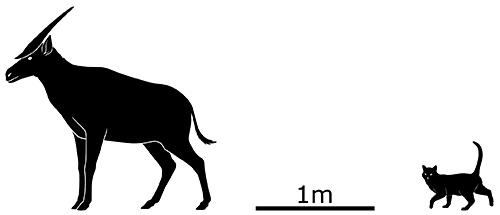The nose-forks and head-crests we saw last time weren’t the only unusual headgear in ancient ruminants.
The giraffoids are represented today by just pronghorns, giraffes, and okapi, but in the past they were much more diverse, modifying their prongs and ossicones into multiple sets of horns, or into deer-like and moose-like antler shapes.
And Prolibytherium was probably the most striking of the lot.
Two different species have been identified, with Prolibytherium magnieri here living in North Africa during the early-to-mid Miocene, about 17-16 million years ago. Its exact evolutionary relationships are uncertain but it was probably part of a group called climacoceratids, deer-like giraffoids which often had thorny branching ossicones that resembled antlers.
It stood around 1.2m tall at the shoulder (~4′), and exhibited dramatic sexual dimorphism – females had slender forked horn-like ossicones, while those of the males flared out into large wide flat shapes that resembled butterfly wings.
Heavy reinforcement in the bones of the back of the males’ skulls helped to support all the extra weight of those huge ossicones, and if they actually used the structures to fight with each other then this may have also provided some protection or shock absorption.


